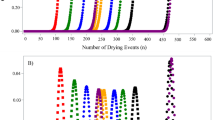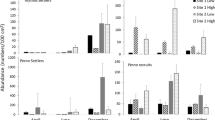Abstract
Deployment of artificial substrata is a common method of investigating early community development and recruitment, but rarely are such experiments of long enough duration to include even year time scales. We placed replicate, machined-slate panels (15×15 cm) in the intertidal and at depths of 6 and 12 m at two sites of differing flow rate at Lough Hyne, SW Ireland. These were serially replaced every 30–60 days for a period of 5 years (1997–2002), except in the intertidal (2000–2002). The number and identity of all recruits were recorded. Recruitment varied over several orders of magnitude both on temporal and spatial scales. The greatest source of variability was between the intertidal (with few species or recruit numbers) and the subtidal zones (many species, some with thousands of recruits per panel per 30 days). Highest levels of recruitment occurred at the low-flow site (Labhra Cliff). Here, recruitment was dominated by the serpulid polychaete, Pomatoceros sp., reaching ~4000 individuals per panel per 30 days. Highest species richness occurred, however, at the high flow site (Whirlpool Cliff). At this site more colonial forms (e.g. bryozoans) settled. Season was found to be the dominant pattern explaining subtidal recruit and species number variability. Year, however, was the dominant temporal pattern explaining change in diversity (Shannon–Wiener H′). In space, depth explained most variability of recruit numbers, whereas site explained more variation in species richness. Both these spatial factors contributed similarly to variability of diversity (H′). Recruitment has long been known to vary considerably over large spatial scales, such as with latitude and isolation, but we that show changes of a similar magnitude in recruitment can occur across small spatial scales. Individual taxa showed varied temporal patterns of recruitment including continuous, regular seasonal fluctuations and irregular pulses in particular years.





Similar content being viewed by others
References
Archambault P, Bourget E (1999) Influence of shoreline configuration on spatial variation of meroplanktonic larvae, recruitment and diversity of benthic subtidal communities. J Exp Mar Biol Ecol 238:161–184
Ballard L (1996) The ecology of gelatinous zooplankton in Lough Hyne Marine Nature Reserve, Co. Cork, Ireland. PhD thesis, National University of Ireland, Cork
Barkai A, Branch GM (1988) The influence of predation and substratal complexity on recruitment to settlement plates: a test of the theory of alternative states. J Exp Mar Biol Ecol 124:215–237
Barnes DKA (1996) Low levels of colonisation in Antarctica: the role of bryozoans in early community development. In: Gordon DP, Smith AM, Grant-Mackie JA (eds) Bryozoans in space and time. National Institute of Water and Atmospheric Research, Wellington, pp 19–28
Barnes DKA (2002) Invasions by marine life on plastic debris. Nature 416:808–809
Barnes DKA, Verling E, Crook A, Davidson I, O’Mahoney M (2002) Local population disappearance follows (20 years after) cycle collapse in a pivotal ecological species. Mar Ecol Prog Ser 226:311–313
Bassindale RE, Ebling FJ, Kitching JA, Purchon RD (1948) The ecology of the Lough Ine rapids with special reference to water currents. I. Introduction and hydrography. J Ecol 36:305–322
Bassindale RE, Davenport E, Ebling FJ, Kitching JA, Sleigh MA, Stone JF (1957) The ecology of Lough Ine rapids with special reference to water currents. VI. The effects of the rapids on the hydrography of the south basin. J Ecol 45:879–900
Bell JJ (2001) The influence of flow rate, depth and surface inclination on the density and the distribution of temperate Anthozoa. J Mar Biol Assoc UK 81:3729
Bell JJ, Barnes DKA (2002) The relationship between sedimentation, flow rates, depth and time at Lough Hyne Marine Nature Reserve. Ir Nat J 27:18–28
Brown KM, Swearingen DC (1998) Effects of seasonality, length of immersion, locality and predation on an intertidal fouling assemblage in the northern Gulf of Mexico. J Exp Mar Biol Ecol 225:107–121
Caffey HM (1985) Spatial and temporal variation in settlement and recruitment of intertidal barnacles. Ecol Monogr 55:313–332
Carlton JT, Hodder J (1995) Biogeography and dispersal of coastal marine organisms—experimental studies on a replica of a 16th century sailing vessel. Mar Biol 121:721–730
Castric-Fey A (1983) Recrutement, croissance et longevite de Pomatoceros lamarckii sur plaques experimentales, en baie de concarneau (sud-finestere). Ann Inst Oceanogr 59:69–91
Chalmer PN (1982) Settlement patterns of species in a marine fouling community and some mechanisms of succession. J Exp Mar Biol Ecol 58:73–85
Corten A (1990) Long-term trends in pelagic fish stocks of the North Sea and adjacent waters and their possible connection to hydrographic changes. Neth J Sea Res 25:227–235
Cushing DH (1975) Marine ecology and fisheries. Cambridge University Press, Cambridge
Dayton PK (1989) Interdecadal variation in an Antarctic sponge and its predators from oceanographic climate shifts. Science 245:1484–1486
Dean TA, Hurd LE (1980) Development in an estuarine fouling community: the influence of early colonists on later arrivals. Oecologia 46:295–301
Dulvy NK, Mitchell RE, Watson D, Sweeting C, Polunin NVC (2002) Spatial scale-dependent top-down control of mesoinvertebrates along a Fijian fishing gradient. J Exp Mar Biol Ecol 278:1–29
Ekman JE (1983) Hydrodynamic processes affecting benthic recruitment. Limnol Oceanogr 28:241–257
Elner RW, Vadas RL (1990) Inference in ecology: the sea urchin phenomenon in the northwestern Atlantic. Am Nat 136:108–125
Guppy HB (1889) The Cocos-Keeling Islands. Scott Geogr Mag 5:281–297
Hayward PJ, Ryland JS(1995) Handbook of the marine fauna of north-west Europe. Oxford University Press, Oxford
Holmes NJ, Harriot VJ, Banks SA (1997) Latitudinal variation in patterns of colonisation of cryptic calcareous marine organisms. Mar Ecol Prog Ser 155:103–113
Keough MJ (1983) Patterns of recruitment of sessile invertebrates in two subtidal habitats. J Exp Mar Biol Ecol 66:213–245
Keough MJ (1984) Effects of patch size on the abundance of marine sessile invertebrates. Ecology 65:423–437
Kitching JA (1987) Ecological studies at Lough Hyne. Adv Ecol Res 17:115–186
Kitching JA, Ebling FJ (1967) Ecological studies at Lough Ine. Adv Ecol Res 4:197–292
Lapointe L, Bourget E (1999) Influence of substratum heterogeneity scales and complexity on a temperate epibenthic marine community. Mar Ecol Prog Ser 189:159–170
Maturo FJS (1959) Seasonal distribution and settling rates of estuarine Bryozoa. Ecology 40:116–127
Maughan BC (2000) Ecology of encrusting epifauna in Lough Hyne Marine Nature Reserve, Co. Cork, Ireland. PhD thesis, National University of Ireland, Cork
Maughan BC (2001) The effects of sedimentation and light on recruitment and development of a temperate, subtidal, epifaunal community. J Exp Mar Biol Ecol 256:59–71
Maughan BC, Barnes DKA (2000a) Epilithic boulder communities of Lough Hyne, Ireland: the influences of water movement and sediment. J Mar Biol Assoc UK 80:767–776
Maughan BC, Barnes DKA (2000b) Seasonality of competition in early development of subtidal encrusting communities. Mar Ecol 21:205–220
McCook LJ, Chapman ARO (1997) Patterns and variations in natural succession following massive ice-scour of a rocky intertidal seashore. J Exp Mar Biol Ecol 214:121–147
Menge BA (1991) Relative importance of recruitment and other causes of variation in rocky intertidal community structure. J Exp Mar Biol Ecol 146:69–100
Minchin D (1992) Multiple species, mass spawning events in an Irish sea lough: the effect of temperatures on spawning and recruitment of invertebrates. Invertebr Reprod Dev 22:229–238
Mook DH (1981) Effects of disturbance and initial settlement on fouling community structure. Ecology 62:522–526
Moran PJ (1986) The acanthaster phenomenon. Oceanogr Mar Biol Annu Rev 24:379–480
Nandakumar K (1995) Competitive interactions among sessile organisms in Tomioka Bay, South Japan: importance of light conditions on the panel surface. Mar Biol 121:713–719
Nowell ARM, Jumars PA (1984) Flow environments of aquatic benthos. Annu Rev Ecol Syst 15:303–328
O’Riordan RM, Myers AA, Cross TF (1992) Brooding in the intertidal barnacles Chthamalus stellatus (Poli) and Chthamalus montagui Southward in south-western Ireland. J Exp Mar Biol Ecol 164:135–145
Osman RW (1977) The establishment and development of a marine epifaunal community. Ecol Monogr 47:37–63
Osman RW, Whitlatch RB (1998) Local control of recruitment in an epifaunal community and the consequences to colonization processes. Hydrobiologia 375/376:113–123
Picton BE (1991) The sessile fauna of sublittoral cliffs. In: Myers AA, Little C, Costello MJ, Partridge JC (eds) The ecology of Lough Hyne. Proceedings of a conference. Royal Irish Academy, Dublin, pp 139–142
Pisano E, Boyer M (1985) Development of an infralittoral bryozoan community in the western Mediterranean Sea. Mar Ecol Prog Ser 27:195–202
Planque B, Fox CJ (1998) Interannual variability in temperature and the recruitment of Irish Sea cod. Mar Ecol Prog Ser 172:101–105
Relini G, Zamboni N, Tixi F, Torchia G (1994) Patterns of sessile macrobenthos community development on an artificial reef in the Gulf of Genoa (northwestern Meditarranean). Bull Mar Sci 55:745–771
Renouf LPW (1931) Preliminary work of a new biological station (Lough Ine, Co. Cork, I.F.S.). J Ecol 19:410–438
Rice JC (2000) Evaluating fishery impacts using metrics of community structure. ICES J Mar Sci 57:682–688
Richards AF (1958) TransPacific distribution of floating pumice from Isla San Benedicto. Deep-Sea Res 5:29–35
Roberts D, Rittschof D, Holm E, Schmidt AR (1991) Factors influencing initial larval settlement: temporal, spatial and surface molecular components. J Exp Mar Biol Ecol 150:203–211
Rodrigues SR, Ojeda FP, Inestrosa NC (1993) Settlement of benthic marine invertebrates. Mar Ecol Prog Ser 97:193–207
Rothschild BJ (2000) Fish stocks and recruitment: the past thirty years. ICES J Mar Sci 57:191–201
Scheer BT (1945) The development of marine fouling communities. Biol Bull (Woods Hole) 89:103–121
Scheltema RS (1971) The dispersal of larvae of shoal-water benthic invertebrate species over long distances by ocean currents. In: Crisp D (ed) Proc 4th Eur Mar Biol Symp. Cambridge University Press, Cambridge, pp 7–28
Scheltema RS (1986) On dispersal and planktonic larvae of benthic invertebrates: an eclectic overview and summary of problems. Bull Mar Sci 39:290–322
Schoener A, Long ER, DePalma JR (1978) Geographic variation in island colonisation curves. Ecology 59:367–382
Smith SDA, Rule MJ (2002) Artificial substrata in a shallow sublittoral habitat: do they adequately represent natural habitats or the local species pool? J Exp Mar Biol Ecol 277:25–41
Southward AJ (1980) The western English Channel—an inconsistent ecosystem? Nature 285:361–366
Stanwell-Smith D, Barnes DKA (1997) Benthic community development in Antarctica: recruitment and growth on settlement panels at Signy Island. J Exp Mar Biol Ecol 212:61–79
Sutherland JP, Karlson RH (1977) Development and stability of the fouling community at Beaufort, North Carolina. Ecol Monogr 47:425–466
Todd CD, Turner SJ (1986) Ecology of intertidal and sublittoral cryptic epifaunal assemblages. I. Experimental rationale and the analysis of larval settlement. J Exp Mar Biol Ecol 99:199–231
Turner JR, Todd CD (1993) The early development of epifaunal assemblages on artificial substrata at two intertidal sites on an exposed rocky shore in St. Andrews Bay, N.E. Scotland. J Exp Mar Biol Ecol 166:251–272
Turner JR, Todd CD (1994) Competition for space in encrusting bryozoan assemblages: the influence of encounter angle, site and year. J Mar Biol Assoc UK 74:603–622
Turner JR, Warman CG (1991) The mobile fauna of sublittoral cliffs. In: Myers AA, Little C, Costello MJ, Partridge JC (eds) The ecology of Lough Hyne. Proceedings of a conference. Royal Irish Academy, Dublin, pp 127–138
Underwood AJ, Fairweather PG (1989) Supply-side ecology and benthic marine assemblages. Trends Ecol Evol 4:16–20
Wahl M (2001) Small scale variability of benthic assemblages: biogenic neighborhood effects. J Exp Mar Biol Ecol 258:101–114
Zar JH (1999) Biostatistical analysis, 4th edn. Prentice-Hall, London
Acknowledgements
We would like to thank Dr. J. Bell, I. Davidson, K. Rawlinson and Dr. E. Verling for assistance in fieldwork. We thank University College Cork technicians A. Whittaker and B. McNamara for maintenance of field equipment and D. O’Donnell of Duchas for granting our research permit to work inside the Marine Nature Reserve of Lough Hyne. We also thank Prof. C. Todd (Gatty Marine Laboratory, University of St. Andrews) for making available the experimental apparatus (panels) used in this study. Finally, we would especially like to thank Dr. R. O’Riordan and Prof. T. Cross for comments on the manuscript and Dr. A.-M. Power for assisting with the ANOVA analysis.
Author information
Authors and Affiliations
Corresponding author
Additional information
Communicated by J.P. Thorpe, Port Erin
Rights and permissions
About this article
Cite this article
Watson, D.I., Barnes, D.K.A. Temporal and spatial components of variability in benthic recruitment, a 5-year temperate example. Marine Biology 145, 201–214 (2004). https://doi.org/10.1007/s00227-003-1291-5
Received:
Accepted:
Published:
Issue Date:
DOI: https://doi.org/10.1007/s00227-003-1291-5




